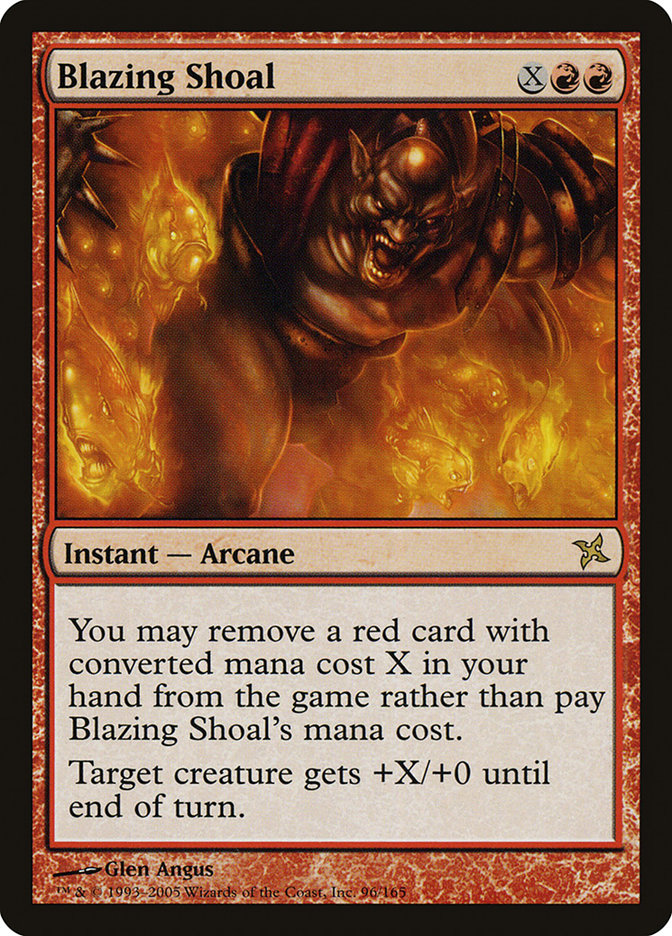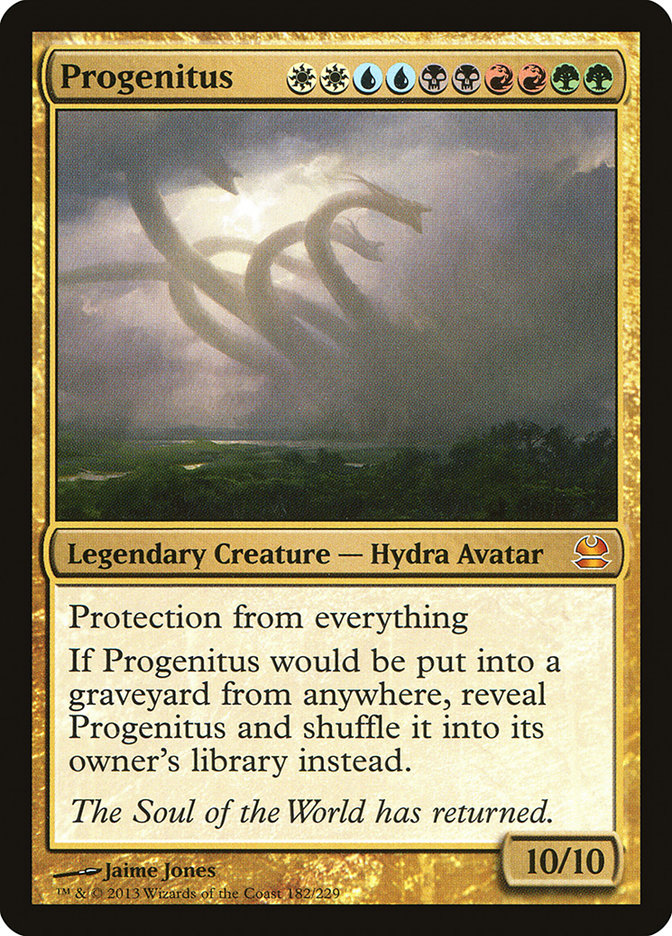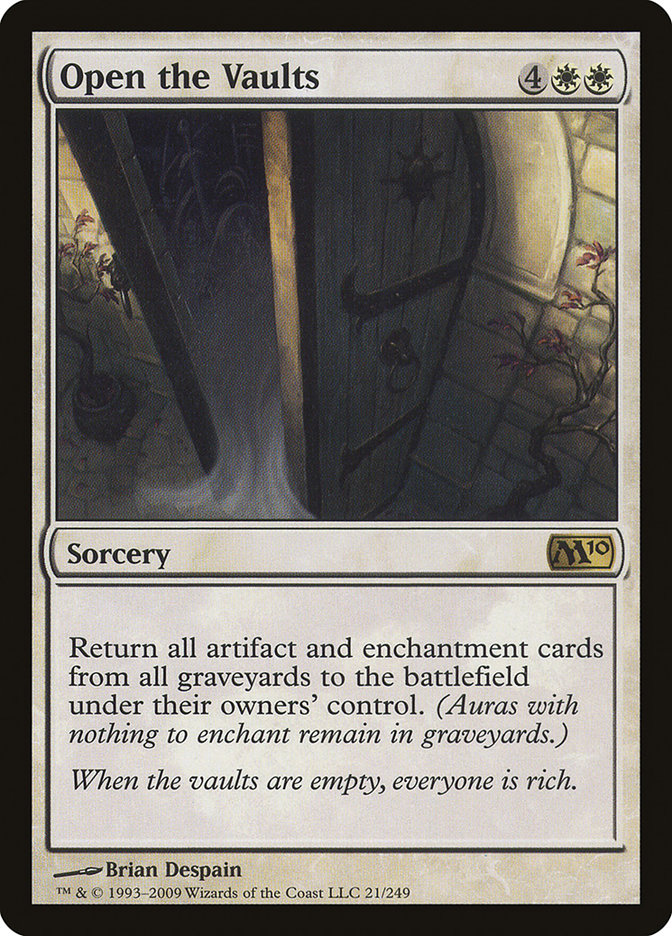Modern is a helluva format. Love it or hate it, Wizards is intent on making it Magic’s next big thing, so if you’re into competitive play you better be ready to learn it. Personally, I haven’t had much of a reason to play the format. Last year I bombed one PTQ with U/W/R Delver and managed to spike one with Affinity, but that’s about it. Even still, I’ve followed the format intently since the days of Progenitus being removed to Blazing Shoal on infect creatures. With ridiculousness like that going on, how could I stay away?
If you check today, you’ll find that Blazing Shoal is on the banned list. In Modern, there always seems to be some degenerate combo running around that eventually leads to a banning. Another great example of this is Stanislav Cifka Eggs deck from Pro Tour Return to Ravnica in Seattle. Eggs established itself as a dominant deck in the format that was doing something unfair and unfun, leading to Wizards banning Second Sunrise. In a relatively new format with a large card pool, this is bound to happen. With access to so many potentially breakable cards, there could be tons of degenerate combos waiting just below the surface. You simply have to look for them.
So what have I got to show you today? Even though I haven’t put much actual playtime into Modern, I have done a lot of brewing with it. I don’t have much of a choice really; the idea of obscure combos sneaking around drives me crazy. A while ago I did some work on an artifact-based combo deck that is similar to Eggs. One of the biggest problems I had with it at the time was that it usually won a turn slower than Eggs. In a format defined by Eggs, that wasn’t exactly where you wanted to be. Fortunately, I recently read an article by Mr. Conley Woods that reminded me the deck can now work with Eggs out of the format. Before I get into the nitty-gritty of it, let’s look at the decklist:
Creatures (11)
Lands (9)
Spells (40)
- 2 Plains
- 7 Island
- 4 Krark-Clan Ironworks
- 2 Grinding Station
- 2 Thoughtcast
- 4 Terrarion
- 4 Chromatic Star
- 1 Grapeshot
- 2 Cloud Key
- 4 Open the Vaults
- 4 Mox Opal
- 4 Ichor Wellspring
Sideboard

Although this deck is similar to Conley’s, it runs on a different axis. To truly understand the deck’s plan, I think the best place to start is defining how the deck wins.
Myr Retriever acts as both the best card in the deck and how you actually win the game. A winning board state will usually involve two Myr Retrievers, two cost-reduction effects, and a Grinding Station. That sounds a lot harder to set up than it actually is. Once this engine is in play, you can sacrifice Myr Retriever to the Station and return the other Myr Retriever to your hand to mill your opponent for three. With two cost-reduction effects, Myr Retriever will be free to play, so you can cast it again, untap the Grinding Station, and mill your opponent out. Alternatively, you can use Krark-Clan Ironworks and two Myr Retrievers to generate infinite storm for Grapeshot.
I know that sounds like a lot of hoops to jump through for a combo. However, when it comes down to it, the combo is neatly wrapped up in a single card:
All of the tools we need to win are artifacts! Because of this, our game plan shifts from getting everything into play to getting everything into the graveyard and casting a game-winning Open the Vaults.
One of the biggest downfalls to a strategy like this can be that the cards you’re trying to use to win aren’t relevant until the turn you win and are useless to have in hand. The original combo that led me to work on this deck suffered from this shortcoming. At first I was building around Myr Moonvessel, Enduring Renewal, and Grinding Station. The idea here was similar: use Renewal and Grinding Station to infinitely sacrifice and replay the Myr. Sure, all of these pieces came into play off of Open the Vaults, but before actually assembling the combo they did absolutely nothing on their own.
My favorite part about this version of the deck is that the combo cards are also the cards that make the deck tick. Let’s break some of them down.
Grinding Station
As mentioned above, Grinding Station is involved in how you actually win the game. However, it is also one of the deck’s engines. Since the plan is to get the combo into the graveyard, casting a turn 2 Grinding Station can help make it happen. All of the cantrip artifacts draw a card no matter how they hit the graveyard from play, so sacrificing them to Grinding Station will still generate value.
Cloud Key, Etherium Sculptor, and Krark-Clan Ironworks
All three of these cards serve as ways to cheat mana in the early game and enable the combo win once you are set up. Having even one reduction effect in play makes the cantrips cost zero-to-one mana, allowing you to churn through the deck with ease. Once there are two in play, all the artifacts are basically free outside of the blue in Etherium Sculptor. One of the cute things to note about Cloud Key is that in a pinch you can name sorcery to hard cast Open the Vaults a turn sooner. It sure isn’t pretty, but it has won me more than a few games.
Krark-Clan Ironworks is very important for creating a critical mass of mana to allow you to go through a lot of cantrips in one turn. The way most games play out you’re looking to cast a turn three Ironworks and win the following turn with Open the Vaults. Keep in mind that you can sacrifice Darksteel Citadel to the Ironworks as well as any spare Mox Opals. You can tap an Opal for mana and then sacrifice it to play a second one to use for colored mana all in the same turn. In addition, thanks to the new legend rule, when you cast Open the Vaults with multiple Opals in the graveyard, you will still be able to keep one around.
Riddlesmith, Thoughtcast, and the "Eggs"
The Eggs are an extremely important part of helping this deck function. Because you need to draw critical cards to win the game, filling the deck with cantrips makes things more consistent. By filling your graveyard up with cantrip artifacts, you can cast your first Open the Vaults for value. As long as you can ensure you will draw a lot of cards and generate a lot mana, it is perfectly ok to cast Open the Vaults when it won’t actually win the game.
Riddlesmith is a great way to churn through the deck quickly and fill your graveyard up with artifacts. Getting a free loot with every cantrip will help generate a winning Open the Vaults in no time. You can also use it to get rid of extra chaff you might have, such as a spare Ironworks or Opal. Making sure you can dig to the important cards quickly is essential.
Thoughtcast plays the simple role of draw spell to give the deck a little velocity. Although it doesn’t do anything flashy being able to pick up a cheap two for one is nice when so many of the cards in your deck are low impact.
Myr Retriever
By far my favorite card in the deck. As long as you can get it into the graveyard, Myr Retriever is anything you want it to be. Need raw card advantage? Grab a Wellspring. Some colored mana perhaps? There’s that Chromatic Star. Aw, did you grind away that Ironworks you need? The Myr has your back. The fact you get so much versatility from a card you use to actually win the game is awesome. Being able to chump block for value against aggressive decks isn’t irrelevant either.
Open the Vaults and Grapeshot
As I said earlier, don’t be afraid to cast your first Open the Vaults for value. As long as you have enough mana to actually run the sorcery out there, it is usually correct. You’ll draw so many cards and be able to generate so much mana with Ironworks that the second copy will seal the deal. The only other thing to note is that Open the Vaults applies to EACH player’s graveyard. Make sure to pay attention to any shenanigans your opponent might be able to pull.
Grapeshot is really the only card that can be stuck as a blank in your hand. I still like having it in the deck as an alternate win condition because it lets you win without Grinding Station in play and can beat an opponent packing Emrakuls. Sometimes you can even just use it for a moderate storm count to reset the board against more midrangey decks.
All in all, this deck is a ton of fun to play and attacks the format from a unique angle. A lot of playing the deck is learning its motions and limits, so if you’re interested in playing it, the best thing to do is practice with it. I personally won’t be able to attend Grand Prix Detroit, but a lot of my close friends will be there, so you know my eyes will be glued to the coverage.
I hope you enjoyed my take on doing something degenerate in Modern. If anyone else has any wonky combos they’ve tried, I’d love to hear about them in the comments!



